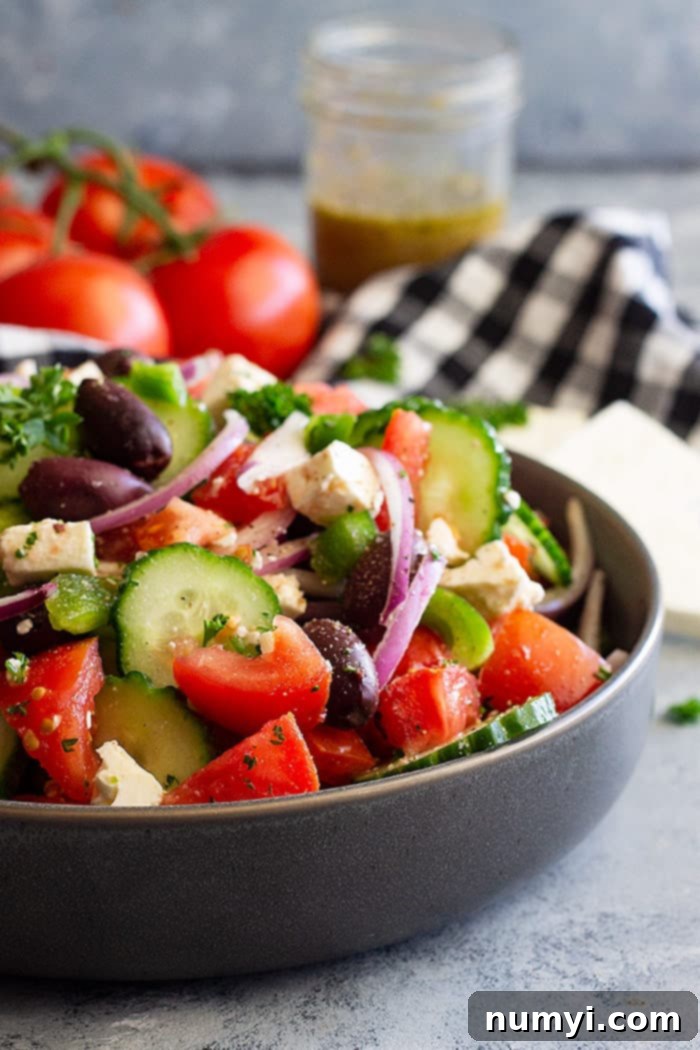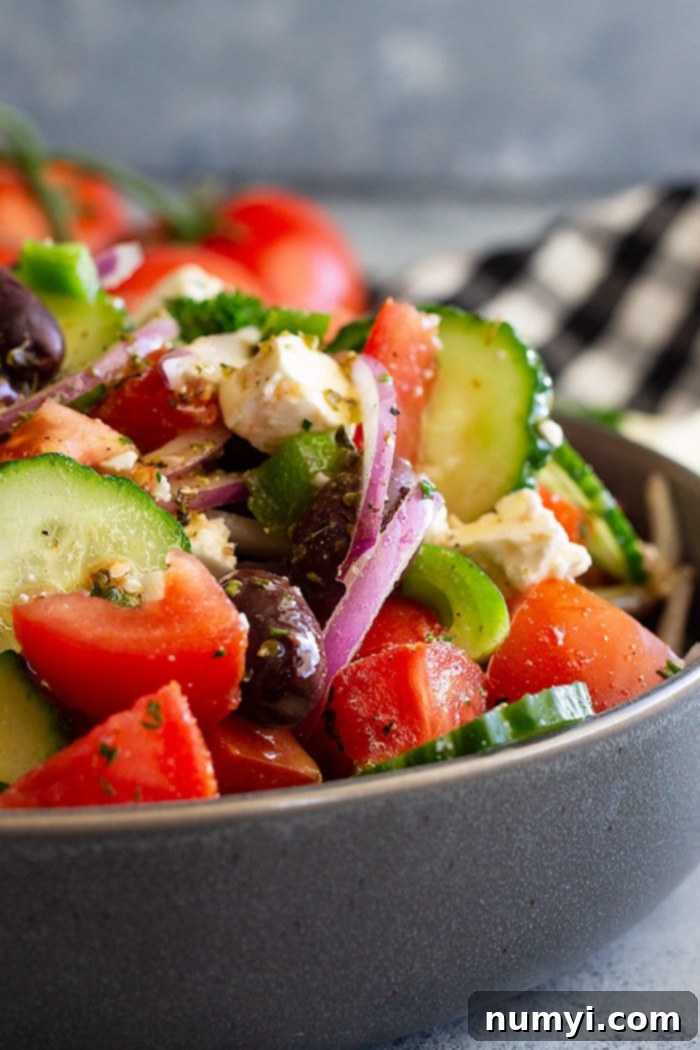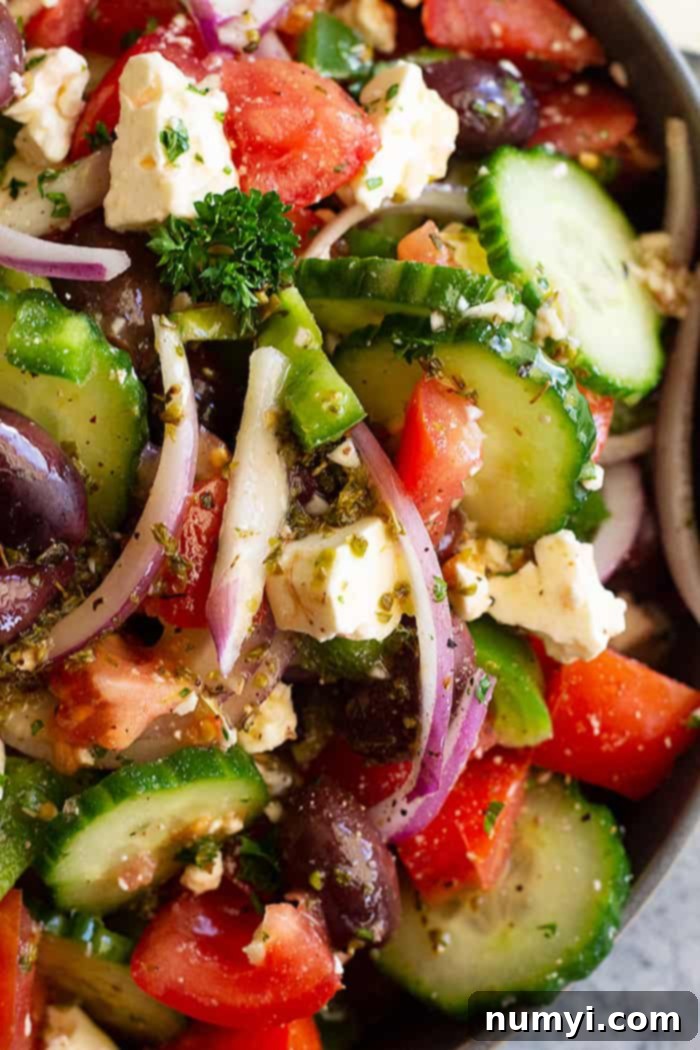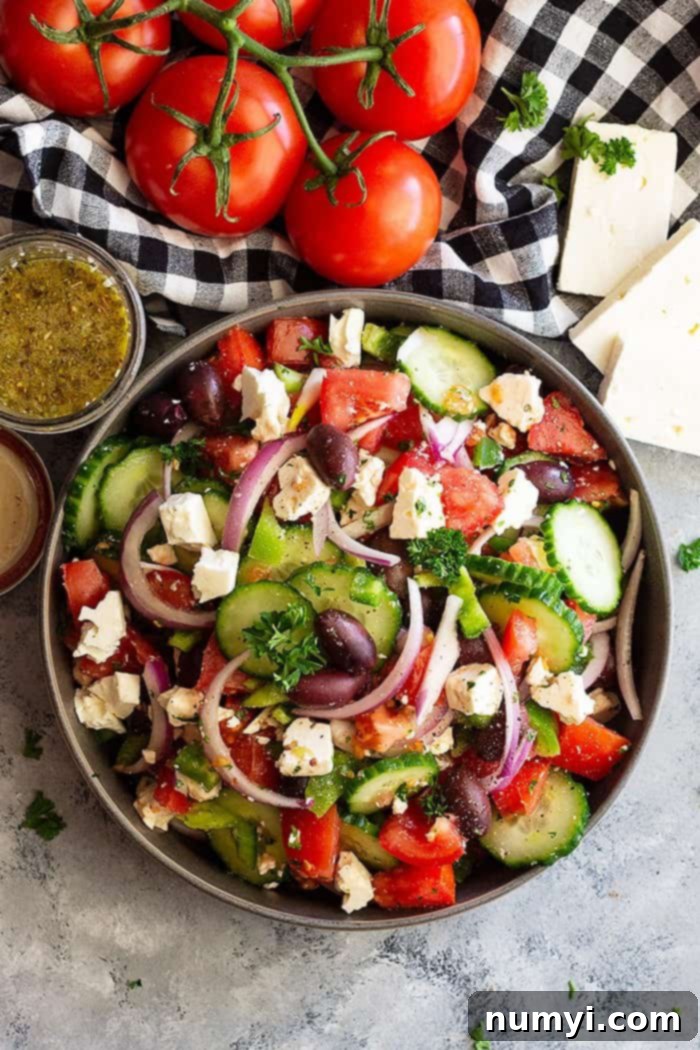Easy Greek Salad: A Fresh, Healthy, and Flavorful No-Lettuce Recipe for Any Occasion
Craving a healthy, refreshing meal that goes beyond your usual spinach or kale? This Easy Greek Salad is your perfect solution! Bursting with vibrant flavors and a delightful crunch, it features a simple, homemade dressing and pairs beautifully with grilled chicken or fresh seafood for a complete, satisfying meal.

A Refreshing Salad to Elevate Your Mealtime
Let’s be honest, even the biggest salad enthusiasts can get tired of eating leafy greens day after day. That’s why I’m always on the lookout for exciting ways to incorporate a bounty of healthy vegetables into my diet, without relying solely on spinach or kale. This Easy Greek Salad is a fantastic example, offering a delightful change of pace with its robust flavors and satisfying textures.
If you’re looking to diversify your salad repertoire, similar fresh and vibrant options like this Grilled Corn Salad with Tomato and Avocado or the wholesome Chicken Avocado and Tomato Salad are some of my personal favorites. And for those who do enjoy a leafy base, my Tuscan Tuna Salad offers a delicious twist.

Crafting the Best Easy Greek Salad
This Greek salad recipe truly shines as a fantastic dish to enjoy throughout the year, bringing a taste of the Mediterranean to your table no matter the season. Its beauty lies in the simplicity of fresh ingredients coming together to create an explosion of flavor.
However, it’s important to note that this salad is best enjoyed fresh. To maintain its optimal texture and prevent sogginess, I recommend preparing and serving it no more than two hours before you plan to eat. The fresh tomatoes and cucumbers naturally release liquid over time, which can make the salad a bit watery if left too long. If you’re planning to make it ahead, consider keeping the dressing separate and only tossing it with the vegetables right before serving. This simple trick ensures every bite is crisp and full of flavor. Personally, I’m not overly picky and will still happily enjoy any leftovers the next day, but for the ultimate experience, fresh is always best!
Why This Easy Greek Salad Stands Out
What makes this Greek salad truly exceptional? It’s the perfect harmony of robust, fresh ingredients combined with a tangy, herbaceous homemade dressing. Unlike many salads that rely heavily on a single green, this one celebrates a medley of crunchy, juicy vegetables. It’s a delightful symphony of textures and tastes – from the sweetness of ripe tomatoes to the sharp kick of red onion and the briny goodness of Kalamata olives. This combination creates a truly unforgettable culinary experience that’s both healthy and incredibly satisfying.

Essential Ingredients for Your Authentic Easy Greek Salad
A truly traditional Greek salad, often called “Horiatiki” in Greece, is a vibrant celebration of simple, high-quality produce. It typically focuses on a few key ingredients that are allowed to shine. Here’s a breakdown of the core components you’ll always find, along with my personal additions that elevate the flavor:
Traditional Greek Salad Ingredients ALWAYS include:
- Tomato: The riper, the better for sweetness and juiciness.
- Cucumber: Crisp and refreshing, providing a cool contrast.
- Red Onion: Offers a sharp, pungent bite crucial to the salad’s character.
- Green Bell Pepper: Adds a fresh, slightly bitter, and crunchy element.
- Kalamata Olives: Briny and rich, these are non-negotiable for authentic flavor.
- Feta Cheese: Creamy, salty, and tangy, it’s the star of the show.
- Dried Oregano: The quintessential Greek herb, providing aromatic depth.
- Red Wine Vinegar: Essential for that signature tangy dressing.
- Good Extra Virgin Olive Oil: The foundation of any excellent Greek dressing.
While I deeply respect tradition, I believe in adding a touch of personal flair to enhance the experience. That’s why I’ve added a few extra ingredients to my Easy Greek Salad recipe: fresh parsley for an herbaceous lift, minced garlic for a pungent kick, and a touch of Dijon mustard to the dressing for an extra layer of savory depth. These additions, for me, truly amplify the salad’s overall profile. However, if you prefer to keep your Greek salad strictly traditional, feel free to omit them – it will still be incredibly delicious!

Deep Dive into the Ingredients: Tips for the Best Greek Salad
- Tomatoes: Always opt for the ripest, most flavorful tomatoes you can find. Roma tomatoes, or even larger beefsteak tomatoes, work wonderfully. For a truly authentic Greek presentation, cut them into large, rustic chunks or even wedges. This allows their natural juiciness to contribute to the dressing as you toss the salad.
- Cucumbers: English cucumbers are often preferred for their thinner skin and fewer seeds, making them ideal for this salad as they don’t require peeling or deseeding. If regular slicing cucumbers are all that’s available, be sure to peel them and scoop out any large, watery seeds to prevent your salad from becoming soggy.
- Red Onion: For fresh salads, red onion is truly the only way to go. Its sharp, slightly sweet flavor and beautiful purple hue add essential character. Slice it thinly to ensure it integrates well without overpowering other flavors.
- Green Bell Pepper: Traditionally, only green bell pepper is used in Greek salad for its distinct crispness and slightly bitter note. However, don’t hesitate to experiment with red, orange, or yellow bell peppers if you prefer a sweeter flavor or a more colorful presentation. I won’t tell anyone!
- Kalamata Olives: The quality of your Kalamata olives can make a huge difference. Seek out dark, plump, and rich olives. If you have access to a specialty olive bar, you can often find truly exceptional varieties that enhance the salad’s briny depth. Pitted olives are convenient, but if you enjoy the process, unpitted olives often have superior flavor.
- Feta Cheese: For the most authentic and flavorful experience, a block of feta cheese (preferably packed in brine) is ideal. This allows you to crumble it into larger, uneven chunks, or even slice it into wedges, providing a wonderful textural contrast and bursts of creamy, salty goodness. Pre-crumbled feta can be used in a pinch, but often dries out faster and lacks the same rich flavor.
- Extra Virgin Olive Oil: This is not just any oil; it’s the heart of your Greek dressing. Invest in a good quality, fruity extra virgin olive oil. Its rich flavor forms the base and backbone of the dressing, binding all the other elements together beautifully.
- Red Wine Vinegar: Providing essential tang and brightness, red wine vinegar is crucial for balancing the richness of the olive oil and the saltiness of the feta and olives. It adds that characteristic Mediterranean zest.
- Dried Oregano: This robust herb is synonymous with Greek cuisine. While it’s commonly sprinkled directly over the finished salad, I prefer to incorporate it directly into the dressing. This allows the oregano to rehydrate and infuse the entire dressing with its warm, earthy aroma and flavor.

What Kind of Cheese is Used in Greek Salad? The Feta Factor!
In a traditional Greek salad, Feta Cheese is the undisputed star! It’s a brined curd cheese made in Greece from sheep’s milk, or a mixture of sheep and goat’s milk, giving it a distinct salty and tangy flavor profile that is absolutely essential. When you’re at the grocery store, you’ll typically find feta sold in two forms: pre-crumbled or as a solid block (often packed in brine).
I always recommend opting for the “chunk” or “block” version. Not only is it generally more affordable per ounce, but it also allows you to crumble it yourself into larger, more rustic pieces. These larger chunks provide a creamier texture and a richer burst of flavor with every bite, vastly superior to the often dry and less flavorful pre-crumbled varieties. Plus, block feta tends to stay fresher longer. So, for the best authentic Greek salad experience, chunk feta is definitely the way to go!
Delicious Pairings: What to Serve with Your Easy Greek Salad
This Easy Greek Salad is incredibly versatile and can be enjoyed as a refreshing side dish or transformed into a complete, satisfying meal with the addition of your favorite protein. Here are some fantastic serving suggestions:
- Grilled or Roasted Chicken: Any cooked chicken makes a wonderful pairing. Think juicy grilled chicken breast, tender baked chicken thighs, or even leftover rotisserie chicken. Its lean protein complements the fresh vegetables and tangy dressing perfectly. Try it with this Homemade Oven Roasted Rotisserie Chicken for an ultimate comfort food combination.
- Cooked Seafood: Seafood, especially flaky fish or succulent shrimp, creates a light and healthy meal. I particularly love this salad with a simple cooked salmon fillet, seasoned with a little salt, pepper, and a squeeze of fresh lemon juice. Grilled shrimp or pan-seared scallops would also be exquisite choices.
- Stuffed Pita Bread (YUM!): For a quick and easy lunch or a delightful snack, spoon this vibrant Greek salad into warm pita bread pockets. The soft bread perfectly soaks up the dressing and cradles the crunchy vegetables and feta. Add a dollop of tzatziki for an extra layer of flavor!
- Grilled Lamb or Beef: For a heartier meal, serve your Greek salad alongside traditional grilled lamb chops or tender beef kebabs. The fresh, tangy salad cuts through the richness of the meat beautifully.
- Vegetarian Options: Enhance it with grilled halloumi cheese, chickpeas, or a scoop of hummus for a protein-rich vegetarian meal.
Tips for the Perfect Easy Greek Salad Every Time
Achieving a truly outstanding Greek salad isn’t just about the ingredients; it’s also about the preparation. Here are a few insider tips to ensure your salad is always a hit:
- Chop Evenly: Aim for roughly uniform sizes when chopping your vegetables. This ensures that every bite contains a harmonious blend of flavors and textures, and that the dressing coats everything evenly.
- Chill Your Veggies: Before assembling, make sure your vegetables are well-chilled. A cold salad is always more refreshing and crisp.
- Don’t Over-Dress: Greek salad dressing is potent. Start with half the dressing, toss, and then add more if needed. You want the vegetables to be coated, not swimming.
- Taste and Adjust: Always taste your salad before serving. You might want a little more salt, a grind of fresh black pepper, or a tiny splash more of red wine vinegar to suit your preference.
- Fresh Herbs Make a Difference: While dried oregano is traditional for the dressing, a sprinkle of fresh parsley or even a few fresh mint leaves over the top just before serving can add a lovely burst of freshness.
Storing Your Easy Greek Salad and Making Ahead
As mentioned, this salad is best enjoyed immediately due to the liquids released by the tomatoes and cucumbers. However, if you need to prepare elements in advance or have leftovers, here’s how to manage it:
- Making Ahead: Chop all your vegetables and store them in separate airtight containers in the refrigerator. Prepare the dressing and keep it in a sealed jar. When ready to serve, combine everything and toss with the dressing. This way, your salad stays crisp and fresh.
- Leftovers: If you have leftovers of the dressed salad, store them in an airtight container in the fridge for up to 1-2 days. While it might lose some of its initial crispness and become slightly watery, it will still be perfectly edible and flavorful. Some people even enjoy the softened texture.
- Preventing Sogginess: If you know you’ll have leftovers, only dress the portion you plan to eat immediately. Keep the remaining salad undressed and add dressing when you’re ready to enjoy it again.
Health Benefits of This Mediterranean Gem
Beyond its incredible taste, this Easy Greek Salad is a powerhouse of nutrition, aligning perfectly with the principles of the healthy Mediterranean diet. Here’s why it’s so good for you:
- Rich in Vegetables: Tomatoes, cucumbers, bell peppers, and onions are packed with vitamins, minerals, and antioxidants, supporting overall health and boosting your immune system.
- Healthy Fats: Extra virgin olive oil is a monounsaturated fat, known for its heart-healthy benefits, including lowering bad cholesterol levels.
- Good Source of Calcium and Protein: Feta cheese provides a decent amount of calcium for bone health and protein for muscle repair and satiety.
- Hydrating: Cucumbers and tomatoes have high water content, helping you stay hydrated, especially on warm days.
- Fiber-Rich: The medley of vegetables contributes dietary fiber, aiding digestion and promoting gut health.
- Low Carb (if desired): Naturally low in carbohydrates, it’s a great option for those watching their carb intake, especially when paired with lean protein.
Frequently Asked Questions About Easy Greek Salad
- Can I add other vegetables to this Greek salad?
- Absolutely! While the classic ingredients are listed, feel free to personalize your salad. Artichoke hearts, sun-dried tomatoes, or even a handful of mixed greens (if you’re craving some leafy goodness) can be delicious additions. Just be mindful of maintaining the core Greek flavors.
- Is Greek salad gluten-free?
- Yes, this traditional Greek salad recipe is naturally gluten-free, making it an excellent option for those with gluten sensitivities or preferences. Just double-check your feta cheese for any unexpected additives if you have severe allergies.
- What’s the best way to deseed a cucumber?
- If using regular cucumbers with large seeds, simply slice the cucumber lengthwise, then use a spoon to gently scoop out the watery seed core. This helps prevent excess moisture in your salad.
- Can I use a different vinegar?
- Red wine vinegar is traditional and highly recommended for its classic flavor. However, if you’re in a pinch, apple cider vinegar or white wine vinegar could be substituted, though the flavor profile will be slightly different.
- How do I make the red onion less pungent?
- If you find red onion too strong, after thinly slicing it, you can soak the slices in a bowl of cold water for about 10-15 minutes. Drain them thoroughly before adding to the salad. This mellows their bite considerably.
Easy Greek Salad

Ingredients
SALAD:
- 3 large Roma tomatoes, roughly chopped
- 1 large English cucumber, sliced
- 1 large green bell pepper, roughly chopped
- 1 cup (145g) kalamata olives, pitted
- 1 cup (120g) crumbled feta cheese
- 1 tablespoon chopped fresh parsley, optional
DRESSING:
- 1 clove garlic, minced
- ¼ cup (60ml) extra virgin olive oil
- ¼ cup (60ml) red wine vinegar
- 1 teaspoon dried oregano
- 1 teaspoon Dijon mustard
- salt and pepper to taste
Instructions
-
In a small jar, combine all ingredients for the dressing (minced garlic, extra virgin olive oil, red wine vinegar, dried oregano, Dijon mustard, salt, and pepper). Secure the lid and shake vigorously until well combined. Set aside.
-
In a large mixing bowl, combine all the salad ingredients: roughly chopped Roma tomatoes, sliced English cucumber, roughly chopped green bell pepper, Kalamata olives, crumbled feta cheese, and optional fresh parsley. Gently toss to combine. Just before serving, drizzle with the prepared dressing and toss again until all ingredients are lightly coated. Serve immediately for the best texture and flavor.
Notes
- For superior texture and taste, if you can find a block of feta cheese and crumble it into larger chunks yourself, that is highly recommended. However, pre-crumbled feta will also work if that’s what’s available.
- This Easy Greek Salad is truly best when served fresh, right after assembly. The vegetables are at their crispest and the flavors most vibrant. However, I still enjoy any leftovers the next day, though the texture might be slightly softer.
- Nutrition Information Disclaimer: Please note that nutritional information can vary significantly depending on the specific brands and types of ingredients used. The information provided here is an estimate and should be used as a general guide.
Nutrition
This recipe first appeared on Julie’s Eats & Treats where I am a contributor.
